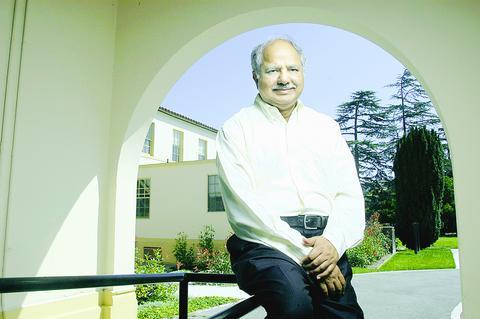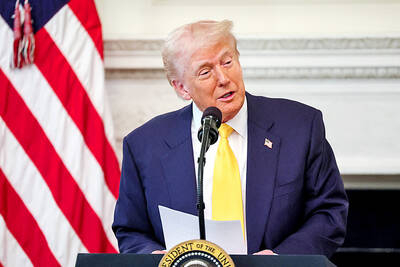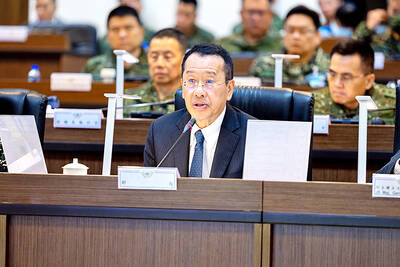Raj Reddy was fed up debating the problem of the digital divide between the rich and the poor and decided to do something about it.
Reddy, a pioneering researcher in artificial intelligence and a professor at Carnegie Mellon University, plans to unveil at the end of this year his new project, called the PCtvt, a US$250 wirelessly networked personal computer intended for the 4 billion people around the world who live on less than US$2,000 a year.

PHOTO: THE NEW YORK TIMES
He says his device can find a market in developing countries, particularly those with large populations of people who cannot read, because it can be controlled by a simple TV remote control and can function as a television, telephone and videophone.
Reddy is hoping his project -- with backing from Microsoft and TriGem, the Korean computer maker, and in partnership with the Indian Institute of Science, the Indian Institute of Information Technology and researchers at the University of California, Berkeley -- can prove that it is possible to bring information technology to impoverished communities without depending on philanthropy.
Because his low-cost computer doubles as a TV and DVD player, Reddy believes that he will be able to use it as a vehicle to take computing and communications to populations that until now have been excluded from the digital world.
What separates Reddy's approach from other efforts is his belief that even the world's poorest communities can become a profitable market for computers.
"I kept asking myself, `What would the device have to do for someone on the other side of the digital divide to be desirable?'" Reddy said.
The answer, he decided, was a simple device that would offer entertainment, making it something that even the world's poorest citizens might be willing to pay roughly 5 percent of their annual income to own.
"Entertainment is the killer app, and that will smuggle something that is a lot more sophisticated into the home," said Tom Kalil, special assistant to the chancellor for science and technology at Berkeley.
Earlier this year Reddy persuaded TriGem, South Korea's third-largest PC maker, to supply prototypes of a fully equipped computer and Microsoft to support the project with an inexpensive, stripped down version of its Windows operating system.
This November Reddy hopes to begin installing the first 100 prototypes of the PCtvt in India and possibly several other countries. The project will work in partnership with University of California researchers who are attempting to develop high-speed wireless digital networks for rural communities.
The philosophy behind the PCtvt grew from ideas explored in the early 1980s by Jean-Jacques Servan-Schreiber, the founder of the World Center for Computing and Human Resources, which is based in Paris. The center was built on the idea that developing countries could use biological and microelectronic technologies to leapfrog the industrial stage of economic development.
Reddy was among dozens of leading international researchers working on design projects at the center, including Alan Kay, Nicholas Negroponte and Seymour Papert. Kay was the creator of the Xerox Alto, an early PC. Negroponte had designed a pioneering videodisc system at the Massachusetts Institute of Technology, and Papert was the inventor of the LOGO programming language.
The French center established a pilot project in Senegal that experimented with adapting the LOGO language for a Third World population. But that project failed years later because of politics and because the computers involved were too expensive.
"We needed three decades," Reddy said, for those technologies to help developing nations. He noted that in the early 1980s, computing was more focused on data processing, while today the focus is communications.
Coincidentally, he said, is that designing a system largely for people who cannot read will require more wireless network bandwidth than is currently required for most modern computer networks, since communication will rely more heavily on audio and video transmissions than on text messages.
With a small team of students and faculty here at Carnegie Mellon University's West Coast campus, Reddy has built a simple control screen that allows the PCtvt to be used for audio and video conferencing, electronic mail and viewing local newspapers on the Web through a TV remote control.
The designers have intentionally limited the computer's functions because they are struggling to simplify what the users see and experience.
One challenge Reddy faced was in persuading Microsoft to offer a version of its Windows software for the project for far less than its commercial price. But Reddy said he eventually won the support of Craig Mundie, the chief technical officer and a senior strategist at Microsoft.
Meanwhile, Reddy's team is also working with social scientists to determine the effect that access to this technology has on communities.
"If we can do these experiments" and show that people living in poverty are a market for computers, Reddy said, "we will have proved something."

STILL COMMITTED: The US opposes any forced change to the ‘status quo’ in the Strait, but also does not seek conflict, US Secretary of State Marco Rubio said US President Donald Trump’s administration released US$5.3 billion in previously frozen foreign aid, including US$870 million in security exemptions for programs in Taiwan, a list of exemptions reviewed by Reuters showed. Trump ordered a 90-day pause on foreign aid shortly after taking office on Jan. 20, halting funding for everything from programs that fight starvation and deadly diseases to providing shelters for millions of displaced people across the globe. US Secretary of State Marco Rubio, who has said that all foreign assistance must align with Trump’s “America First” priorities, issued waivers late last month on military aid to Israel and Egypt, the

‘UNITED FRONT’ FRONTS: Barring contact with Huaqiao and Jinan universities is needed to stop China targeting Taiwanese students, the education minister said Taiwan has blacklisted two Chinese universities from conducting academic exchange programs in the nation after reports that the institutes are arms of Beijing’s United Front Work Department, Minister of Education Cheng Ying-yao (鄭英耀) said in an exclusive interview with the Chinese-language Liberty Times (the Taipei Times’ sister paper) published yesterday. China’s Huaqiao University in Xiamen and Quanzhou, as well as Jinan University in Guangzhou, which have 600 and 1,500 Taiwanese on their rolls respectively, are under direct control of the Chinese government’s political warfare branch, Cheng said, citing reports by national security officials. A comprehensive ban on Taiwanese institutions collaborating or

France’s nuclear-powered aircraft carrier and accompanying warships were in the Philippines yesterday after holding combat drills with Philippine forces in the disputed South China Sea in a show of firepower that would likely antagonize China. The Charles de Gaulle on Friday docked at Subic Bay, a former US naval base northwest of Manila, for a break after more than two months of deployment in the Indo-Pacific region. The French carrier engaged with security allies for contingency readiness and to promote regional security, including with Philippine forces, navy ships and fighter jets. They held anti-submarine warfare drills and aerial combat training on Friday in

COMBAT READINESS: The military is reviewing weaponry, personnel resources, and mobilization and recovery forces to adjust defense strategies, the defense minister said The military has released a photograph of Minister of National Defense Wellington Koo (顧立雄) appearing to sit beside a US general during the annual Han Kuang military exercises on Friday last week in a historic first. In the photo, Koo, who was presiding over the drills with high-level officers, appears to be sitting next to US Marine Corps Major General Jay Bargeron, the director of strategic planning and policy of the US Indo-Pacific Command, although only Bargeron’s name tag is visible in the seat as “J5 Maj General.” It is the first time the military has released a photo of an active